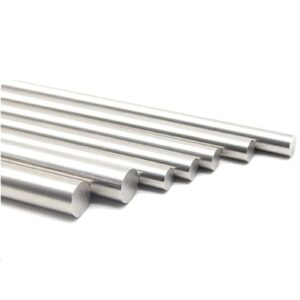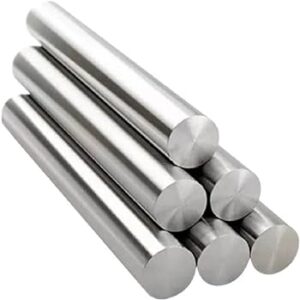Selecting the right round bar material is a critical decision in various industries and applications. Among the options available, 316 stainless steel stands out for its unique properties. In this comprehensive guide, we will explore the differences between 316 stainless steel and other round bar materials, shedding light on why it’s a top choice and when alternative materials may be preferred.
Understanding 316 Stainless Steel Round Bars
Before we delve into the comparisons, it’s essential to grasp the fundamentals of 316 stainless steel round bars.
What are 316 Stainless Steel Round Bars?
316 stainless steel is an austenitic stainless steel alloy containing key elements such as chromium, nickel, and molybdenum. These elements contribute to its remarkable corrosion resistance and mechanical properties. Round bars made from 316 stainless steel are solid cylindrical pieces cut from this material, known for their strength, durability, and versatility.
Comparing 316 Stainless Steel with Other Round Bar Materials
Let’s explore the differences between 316 stainless steel and several other common round bar materials:
316 Stainless Steel vs. 304 Stainless Steel
The Austenitic Battle: 316 vs. 304
Both 316 and 304 stainless steel are austenitic stainless steels, but they differ in their alloy composition. While 316 contains molybdenum, enhancing its corrosion resistance, 304 lacks this element. As a result, 316 stainless steel is more resistant to chloride-induced corrosion, making it preferable for marine and chemical applications.
316 Stainless Steel vs. 316L Stainless Steel
Carbon Content Matters: 316 vs. 316L
316L stainless steel is a low-carbon variant of 316, primarily designed for improved weldability. The main difference lies in the carbon content, with 316L having lower carbon levels. This reduces the risk of sensitization, which can lead to corrosion in certain conditions. 316L is preferred for welding applications where maintaining corrosion resistance is critical.
316 Stainless Steel vs. Duplex Stainless Steels
The Duplex Challenge: 316 vs. Duplex
Duplex stainless steels are known for their high strength and excellent corrosion resistance. They contain a balanced mix of austenite and ferrite phases, offering a unique combination of properties. In some highly corrosive environments, duplex stainless steels may outperform 316. However, the choice depends on specific application requirements and cost considerations.
316 Stainless Steel vs. 317 Stainless Steel
Molybdenum Matters: 316 vs. 317
Stainless steel grade 317 is similar to 316 but has a higher molybdenum content. This higher molybdenum content provides enhanced resistance to certain corrosive substances, particularly sulfuric acid. If your application involves exposure to sulfuric acid or similar chemicals, 317 stainless steel may be a better choice than 316.
316 Stainless Steel vs. Carbon Steel
The Rust Challenge: 316 vs. Carbon Steel
Carbon steel is a widely used material, but it lacks the corrosion resistance of stainless steel. 316 stainless steel is highly resistant to corrosion, making it suitable for applications where rust and corrosion are major concerns. While carbon steel may be less expensive, it often requires additional coatings or maintenance to prevent rust.
316 Stainless Steel vs. Aluminum
Lightweight vs. Corrosion Resistance: 316 vs. Aluminum
Aluminum is a lightweight material known for its low density. However, it lacks the corrosion resistance of 316 stainless steel. In applications where corrosion is a concern, such as marine environments or chemical processing, 316 stainless steel is the superior choice.
316 Stainless Steel vs. Brass
The Alloy Challenge: 316 vs. Brass
Brass is an alloy of copper and zinc. While brass has its applications, it is not as corrosion-resistant as 316 stainless steel. 316 stainless steel is preferred in industries where resistance to corrosion and staining are critical, such as the food and beverage industry.
316 Stainless Steel vs. Titanium
Strength vs. Lightweight: 316 vs. Titanium
Titanium is known for its exceptional strength-to-weight ratio and corrosion resistance. However, it tends to be more expensive than 316 stainless steel. The choice between the two materials depends on the specific application and budget considerations.
316 Stainless Steel vs. Plastics
Durability vs. Versatility: 316 vs. Plastics
Plastics are lightweight and versatile materials used in various industries. However, they cannot match the strength and corrosion resistance of 316 stainless steel. In applications where durability and resistance to harsh environments are crucial, 316 stainless steel is the superior choice.
316 Stainless Steel vs. Inconel
High-Temperature Challenge: 316 vs. Inconel
Inconel is a high-performance alloy known for its resistance to high-temperature and corrosive environments. While Inconel excels in extreme conditions, it is often more expensive than 316 stainless steel. The choice depends on the specific requirements of the application.
FAQ: Frequently Asked Questions
Let’s address some common questions related to the differences between 316 stainless steel and other round bar materials:
Is 316 stainless steel the best material for all applications?
316 stainless steel is an excellent material with high corrosion resistance, but it may not always be the best choice for every application. Specific application requirements, budget constraints, and environmental factors may lead to the selection of alternative materials.
What factors should I consider when choosing between 316 stainless steel and other materials?
Consider factors such as the corrosive environment, temperature extremes, mechanical stress, and cost when choosing between 316 stainless steel and other materials. Consulting with materials engineers and experts can help make informed decisions.
Are there any downsides to using 316 stainless steel?
While 316 stainless steel offers numerous advantages, including corrosion resistance and durability, it may come at a higher initial cost compared to some other materials. Additionally, in extremely aggressive environments, alternative alloys may offer even better corrosion resistance.
Can 316 stainless steel be used in high-temperature applications?
316 stainless steel is suitable for moderate to high-temperature applications, but if extremely high temperatures are involved, specialized materials like Inconel may be more appropriate.
What materials are most cost-effective compared to 316 stainless steel?
Materials like carbon steel and aluminum are often more cost-effective than 316 stainless steel, but they may lack the same level of corrosion resistance and durability.
Conclusion
Selecting the right round bar material is a critical decision that depends on the specific requirements of your application. While 316 stainless steel offers exceptional corrosion resistance and mechanical properties, there are alternative materials with their own unique advantages. Understanding the differences between 316 stainless steel and other materials empowers you to make informed choices that align with your project’s needs and budget constraints.


